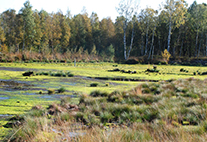Intact natural habitats help to reduce greenhouse gases
29 July 2015, by Franziska Neigenfind

Photo: UHH/CEN/S. Beddig
Corn and canola as far as the eye can see – plants that are processed into biogas and biodiesel can be found in many agricultural fields throughout Europe. Bioenergy is considered to ...
Corn and canola as far as the eye can see – plants that are processed into biogas and biodiesel can be found in many agricultural fields throughout Europe. Bioenergy is considered to be a climate-friendly solution, because during combustion plants release only the amount of carbon dioxide that they removed from the atmosphere during their growth. Wind energy is also intended to reduce greenhouse gases. But those approaches that help the climate can harm nature: regarding corn and canola fields, monocultures and pesticides are a major problem. Wind turbines disrupt bird migration routes and can be deadly for birds and bats. These examples show how difficult it is to mitigate climate change while also preserving vital habitats for plants and animals.
When it comes to climate protection, untouched wetlands are veritable treasure troves
As an environmental scientist, I work together with economists to investigate how the goals of nature and climate protection can be reconciled in a cost-effective manner. Currently, our research focuses on those soils that make an important contribution to the climate. They are the largest depot for organic carbon, containing twice as much carbon as the atmosphere. In this regard, protected areas like intact moors and swampland, as well as riparian zones, are real treasure troves. Not only do they offer habitats for endangered species; they also bind far more carbon in their soils than other areas: though only 12 percent of the worldwide land area is protected, it stores 15 percent of the Earth’s total soil carbon. As such, intact ecosystems are good for animals and plants alike – not to mention the climate. But when soils are laid dry, carbon is released in the form of greenhouse gases.
In order to determine how much European protected areas can potentially contribute to climate protection, we explored the European Union’s designated Natura 2000 areas. Three factors were decisive: spatial data like the size and borders of the areas, the organic carbon content in the upper soil layer and the average price per hectare. We interlinked this data with the help of geo-informational systems, computer-based programs that process spatial data. We then used that information to create a grid gathering more than 4 million datasets, which we evaluated statistically. Since high resolution was one of our foremost priorities, the grid’s mesh size is only one kilometer.
Nature protection and climate protection can be reconciled in a cost-effective manner
Our analyses show that protected areas are often home to high soil carbon levels: on average, soils from the Natura 2000 areas contain 7.5 percent carbon, a level ca. ten percent higher than that in non-protected areas. We also discovered that protected areas are often characterized by lower agricultural productivity than adjacent lands: the average land price in the Natura 2000 areas was ca. 6,000 euros per hectare, compared to slightly more than 7,000 in non-protected areas.
Our new method will also allow us to identify still-unprotected areas with high carbon content and low land prices, which could help to expand the European network of protected areas in a climate-friendly and cost-efficient manner. If protected areas were more actively integrated into climate policy, greenhouse-gas emissions could be reduced using more natural approaches.
More information and contact
